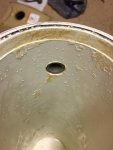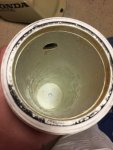Hey all - I have a Rainbow 320 that's been in service for 11 years and required zero maintenance until this year. Earlier in the summer, I noticed that it wasn't consuming the 3" tabs as fast as it has in the past... coincidentally, I was fighting a water quality issue (some slight yellow/green growth on the walls of the pool, which was easily brushed off, consistent with low chlorine residual). We had some really hot days here in the Houston area in July, so it wasn't a complete surprise to be fighting low chlorine, but the fact that I wasn't needing to refill the feeder as much as I had in the past was puzzling. I shock the pool weekly, so it never got too green before I finally put 2 and 2 together and realized I needed to put the tabs in the skimmer baskets temporarily and address the feeder issue.
I've disassembled it and found that the screen at the bottom was nearly completely plugged with a hard residue which has also deposited on the walls of the Rainbow. I removed the screen and tried various methods to clean but the only thing that worked was manual scrubbing with a stiff brush. The same residue had formed a thin layer around the entire inside surface of the cylinder that holds the tabs. Some of it flaked off during my trial and error cleaning, and the flakes then clogged the check valve. The surface of the feeder that's exposed where the flakes have come off is smooth and looks like the original plastic (i.e. not oxidized).
I've tried soaking it for 24 hours in a very strong muriatic acid mixture, but the residue seems indifferent to the acid. I would rather not use a wire brush on the feeder because I feel like scratches will just give the deposits a spot to form faster. I've read that this may be the binder used in forming the 3" tabs, so just wondered if anyone on here knows a good method for chemically cleaning it. I've read several posts here on TFP and realize that chlorinators aren't as popular with the locals, but I have it and don't want advice to switch to bleach. Just comment if you're familiar with this residue and have had success in cleaning it.
Thanks in advance!
I've disassembled it and found that the screen at the bottom was nearly completely plugged with a hard residue which has also deposited on the walls of the Rainbow. I removed the screen and tried various methods to clean but the only thing that worked was manual scrubbing with a stiff brush. The same residue had formed a thin layer around the entire inside surface of the cylinder that holds the tabs. Some of it flaked off during my trial and error cleaning, and the flakes then clogged the check valve. The surface of the feeder that's exposed where the flakes have come off is smooth and looks like the original plastic (i.e. not oxidized).
I've tried soaking it for 24 hours in a very strong muriatic acid mixture, but the residue seems indifferent to the acid. I would rather not use a wire brush on the feeder because I feel like scratches will just give the deposits a spot to form faster. I've read that this may be the binder used in forming the 3" tabs, so just wondered if anyone on here knows a good method for chemically cleaning it. I've read several posts here on TFP and realize that chlorinators aren't as popular with the locals, but I have it and don't want advice to switch to bleach. Just comment if you're familiar with this residue and have had success in cleaning it.
Thanks in advance!



